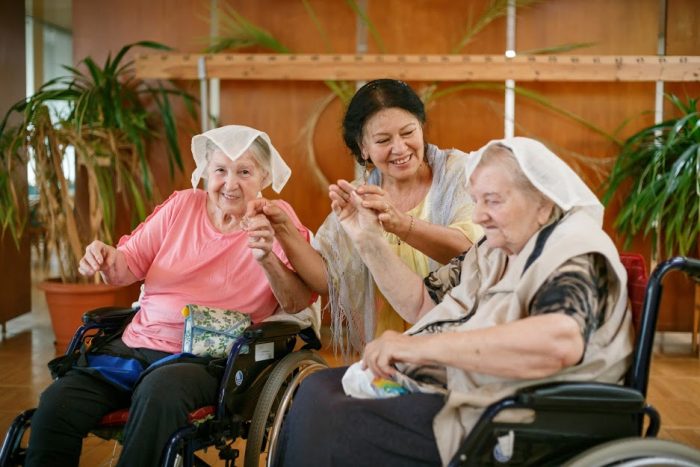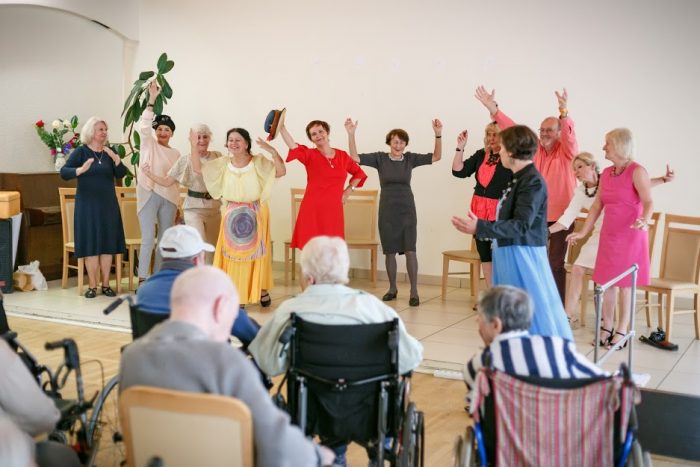What was the idea of the project?
“The primary goal of this project was to create a meeting space for senior adults from a range of circles: both active individuals and those more dependent, withdrawn, and lonely.
The site of contact was an interactive performance prepared by active seniors for their peers living in a residential care home or limited to local senior clubs.
The exceptionality of this performance draws from the fact that seniors had a chance to not only be the actors but also the scriptwriters – it is their life stories and reflections on ageing that provided the basis for the play. It was devised using drama and theatrical techniques. During rehearsals, the participants shared their observations but also learned improvisation, which helped them gain a new perspective combined with a fair share of humour. This allowed them to tell their story about ageing in a spontaneous and free manner. For instance, in scenes such as “The Dinosaur Museum,” they played prehistoric creatures, which also alluded to the stereotypes of the elderly. Throughout the performance, the seniors in the audience were engaged in creative responses to whatever is going on on the stage, which helped break the 4th wall. A key motif uniting the play was a musical throwback to the times of youth and unforgettable dance parties. Around halfway through the performance, the senior actors left the stage and engaged in a personal encounter with the audience via dancing, which closed with a conversation about house parties from back in the day.”

The audience became a co-creator of the play
How did the project foster Life Skills approach?
“To answer that question, let us first consider the group of active seniors who prepared the performance, and next, the group of recipients who lived in care homes and members of the local senior club.
Following the performance, the care home residents were overjoyed and grateful. Even the wheel-chair bound seniors or individuals on crutches joined in moving to the rhythm of the music. The members of the local senior clubs easily and joyfully crossed the line between the actor and the passive viewer, allowing the senior actors to take the lead. According to the interviews conducted with the participants, the event improved their moods, encouraged them to move and dance, and opened them up to a different kind of activity. Some people felt encouraged to join drama and theatre workshops.
As far as the twelve-person group of the senior actors is considered, they have gained increased self-confidence, more ability to express themselves spontaneously and experience joy freely, less anxiety about exposure to ridicule or embarrassment, more ability to share emotions and observations in a group, better touch with one’s body, increased sense of agency and engagement in the course of actions,
and better improvisation skills.”
What was the best practice learned from the project?
“The project explored the potential of seniors to activate and socially include their peers. Active seniors became the animators for the seniors who are dependent, withdrawn, or struggling more with life hardships. Undoubtedly, this is an idea that we would like to promote and use as a basis for our future projects. We believe the approach is valuable primarily because seniors act here as experts in their field and can give shape to the events that they consider interesting and worthwhile. Meanwhile, if children or youths appear on the stage, seniors typically are reduced to the role of passive observers, watching scenes that are disconnected from their reality.

The project brought joy to participants and increased seniors’ sense of worth and happiness
We want to spread the belief about the therapeutic function of culture. The improvised performance, which we successfully put together as part of this project, is an event of a therapeutic and cultural nature. We wish to introduce such activities not only to places such as care homes or senior clubs, but also cultural institutions. We believe that the line between the audience and the actor is arbitrary, and if we want to, it can be crossed because the best cultural event is a person-to-person encounter.”
Mobilizing seniors on and off the stage
Category: National projects
Coordinator: Non-formal group “Synchrony”
Country: Poland
Focus: Promoting active ageing among seniors
Life Skills approach: Development of a positive self-image through theatre and peer communication
Link: Facebook page
Text: Aizhana KhasanovaPhotos: Piotr Bedliński

